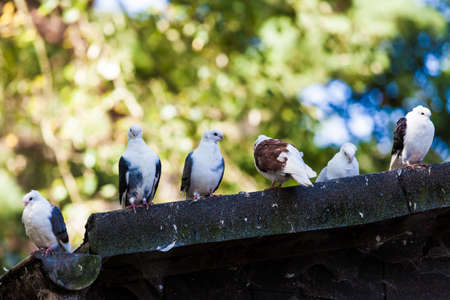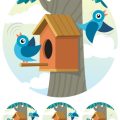Overreliance on Seed-Only Diets
It’s a common scene in many UK homes: a charming budgie or canary pecking away at a dish filled with seeds. While seed mixes have long been considered a staple for pet birds, relying solely on them is one of the most frequent—and potentially harmful—feeding mistakes made by British bird owners. Seeds, though convenient and often enjoyed by birds, lack several essential nutrients necessary for their long-term health and well-being. This issue is particularly important in the UK, where seasonal changes can limit natural foraging opportunities and make dietary variety even more crucial.
Why Seeds Alone Aren’t Enough
Seed-only diets are typically high in fat but low in vital vitamins, minerals, and proteins. Over time, this imbalance can lead to deficiencies, weakened immune systems, poor feather condition, and even chronic health problems such as fatty liver disease or obesity. Below is a simple comparison highlighting the nutritional gaps between seed-only diets and balanced alternatives:
| Seed-Only Diet | Balanced Diet | |
|---|---|---|
| Protein | Low | Adequate (from pellets, legumes, eggs) |
| Vitamins (A, D, E) | Lacking | Plentiful (from fresh veg & formulated feeds) |
| Minerals (Calcium, Iodine) | Poor | Sufficient (from cuttlefish bone & supplements) |
| Fat Content | High | Controlled |
| Fibre | Minimal | Adequate (from fruit & greens) |
The UK Perspective: Seasonal Considerations and Variety
British weather means less access to natural sunlight during winter months, which affects vitamin D synthesis—a nutrient already scarce in seeds. Moreover, local favourites like budgies and cockatiels benefit from seasonal vegetables such as kale or carrots that are readily available in UK supermarkets. Introducing safe British-grown greens not only boosts nutrition but also enriches your pet’s daily routine.
Quick Tip for UK Bird Owners:
Aim to supplement your bird’s diet with quality pellets, fresh vegetables like broccoli or spinach, small amounts of fruit, and occasional protein sources. Always avoid offering avocado or chocolate as these are toxic to birds.
2. Ignoring Fresh Foods
One of the most common mistakes among UK bird owners is relying solely on commercial seed mixes and neglecting the vital role of fresh foods in their pet’s diet. Birds, much like us, thrive when offered a variety of wholesome ingredients that mirror what they might find in the wild. Incorporating fresh fruits, vegetables, and even traditional British garden greens ensures your feathered companion receives essential vitamins, minerals, and antioxidants.
Why Fresh Foods Matter
While seeds provide energy, they often lack many nutrients necessary for a balanced avian diet. A deficiency in vitamins A, C, E, and important minerals can lead to weakened immune systems, dull plumage, and reduced vitality. By offering fresh options daily, you help nurture your bird’s natural curiosity and support their long-term health.
Examples of Bird-Safe Fresh Foods
| Category | Examples | Benefits |
|---|---|---|
| Fruits | Apples (no seeds), pears, berries, grapes (seedless) | Vitamins A & C, antioxidants |
| Vegetables | Carrots, broccoli, sweetcorn, peas | Beta-carotene, fibre |
| British Garden Greens | Kale, dandelion leaves, spinach (in moderation) | Iron, calcium, chlorophyll |
Tips for Safe Feeding
- Wash all produce thoroughly to remove pesticides or soil residue.
- Avoid avocado, onion, chocolate, and other foods toxic to birds.
- Introduce new foods gradually and observe for any adverse reactions.
- Rotate offerings to keep your bird interested and ensure a range of nutrients.
By weaving local garden greens and market-fresh produce into your bird’s daily routine, you not only reflect a touch of British lifestyle but also enrich their wellbeing with nature’s best. Remember: variety is key—think of it as curating a vibrant table setting for your cherished companion!
![]()
3. Miscalculating Portion Sizes
One of the most common mistakes UK bird owners make is misjudging how much food to serve their feathered friends. Overfeeding can lead to obesity, while underfeeding can cause malnutrition—both of which seriously affect your bird’s wellbeing. Unlike dogs or cats, birds have small and sensitive digestive systems, making correct portion sizes absolutely essential for their health.
Understanding Your Bird’s Needs
Different species require different amounts of food. For instance, a budgie needs far less than an African grey parrot. Here’s a handy table for reference:
| Bird Species | Daily Seed/ Pellet Portion (approx.) |
|---|---|
| Budgerigar | 1–2 teaspoons |
| Cockatiel | 1.5–2 tablespoons |
| African Grey Parrot | 3–4 tablespoons |
UK Household Tips for Measuring Portions
- Use a standard kitchen teaspoon or tablespoon for accuracy.
- If you don’t have US-style measuring spoons, most UK teaspoons hold about 5ml and tablespoons about 15ml.
- Keep a dedicated spoon in your bird’s food container to avoid confusion with other household utensils.
The Dangers of Over- and Underfeeding
If your bird is given too much food, especially high-fat seeds or treats, it may become overweight—a growing concern among pet birds in the UK where exercise space is often limited. Conversely, offering too little can deprive them of vital nutrients, leading to lethargy, poor feather condition and even illness.
Practical Steps for UK Homes
- Weigh your bird regularly using a small digital kitchen scale—weight changes can indicate over- or underfeeding.
- Observe uneaten food at the end of the day to gauge if you’re giving too much or too little.
- Adjust portion sizes as needed based on your bird’s activity level and overall condition.
A mindful approach to portion sizes not only supports your bird’s health but also fits seamlessly into the daily routines of British households, ensuring mealtimes are both nourishing and enjoyable for your avian companion.
4. Neglecting Water Hygiene
When caring for pet birds in the UK, water hygiene is just as vital as providing the right food. Many bird owners assume that tap water is always suitable, but there are common oversights when it comes to ensuring your feathered friends have access to safe, clean water. UK tap water, while generally of high quality, can still contain trace amounts of chlorine, minerals, and sometimes even lead from old plumbing systems. Moreover, water left standing in bowls can quickly become a breeding ground for bacteria and algae, especially if not changed daily. This can lead to digestive issues, reduced immunity, and a decline in your bird’s overall health.
Typical Water Hygiene Mistakes Among UK Bird Owners
| Common Oversight | Potential Impact on Birds |
|---|---|
| Using stagnant or unchanged water | Bacterial growth leading to infections |
| Not cleaning water dishes regularly | Build-up of harmful biofilm |
| Assuming all tap water is safe | Pesticide or heavy metal exposure |
| Placing bowls near food or droppings | Cross-contamination risks |
Maintaining Optimal Water Quality at Home
- Change your bird’s drinking water at least twice daily, especially during warmer months.
- Clean all water containers with mild detergent and rinse thoroughly to avoid chemical residues.
- If concerned about tap water quality—especially in older homes with lead pipes—consider using filtered or boiled (then cooled) water.
Practical Tips for UK Households
- Avoid placing water dishes directly under perches to reduce contamination from droppings.
- If you use bottled spring water, ensure it’s free from added minerals and sodium.
Remember:
Your bird’s health thrives on the small details of everyday care. A simple routine of fresh, clean water is one of the easiest yet most overlooked ways to support their well-being and longevity in a British home.
5. Unsafe Human Foods and Treats
It’s a common sight in many UK households to share a nibble of your favourite snack with your feathered companion, but this well-meaning gesture can often do more harm than good. While our pantries are filled with delicious treats, many popular British snacks are simply not suitable for pet birds. Here’s a closer look at what to avoid and some safer alternatives to keep your avian friends happy and healthy.
British Snacks: What to Avoid
Many beloved UK treats contain ingredients that are toxic or unhealthy for birds. Chocolates, crisps, biscuits, and certain savoury nibbles may seem harmless but can pose serious health risks. Ingredients such as salt, sugar, chocolate, caffeine, and artificial additives are especially dangerous for pet birds.
Common Unsafe Treats
| Popular British Snack | Why It’s Unsafe for Birds |
|---|---|
| Chocolate Digestives | Contains chocolate (toxic) and high sugar content |
| Crisps (e.g., Walkers) | High in salt, artificial flavours, and oils |
| Cheese & Onion Pasties | Dairy, onion (toxic), fats |
| Scones with Jam & Cream | Sugar-rich jam and dairy cream |
| Bacon Sandwiches | Salt, processed meat, fatty content |
Safe Alternatives for Treat Time
Your bird doesn’t have to miss out on treat time altogether! There are plenty of natural snacks you can offer instead. Fresh fruits (like apple slices – without seeds), vegetables (such as carrot or broccoli), and unsalted nuts (in moderation) make excellent choices. Just be sure to avoid avocado, fruit seeds/pits, onions, garlic, and mushrooms as these are also unsafe.
| Safe Snack Alternative | Benefits for Birds |
|---|---|
| Chopped Carrots | Rich in beta-carotene; crunchy texture is fun! |
| Sliced Apple (no seeds) | Sweet treat packed with vitamins |
| Pepper Strips | High in vitamin C; colourful and enticing |
| Broccoli Florets | Great source of fibre and nutrients |
A Note on Moderation and Variety
No matter which treats you choose, always offer them in moderation alongside a balanced diet. By being mindful of what goes into your bird’s bowl – steering clear of tempting but unsafe British snacks – you’ll help ensure their wellbeing while still embracing the joys of sharing food within your home.
6. Inconsistent Feeding Schedules
Establishing a reliable feeding routine is essential for the wellbeing of pet birds, yet many UK bird owners unknowingly fall into the habit of irregular mealtimes. Unlike wild birds, who rely on nature’s rhythms, our feathered companions depend entirely on us for their daily sustenance. When feeding times become erratic, it can lead to stress, anxiety, and even health complications such as digestive issues and weakened immune systems.
Why Consistent Feeding Matters
Birds are creatures of habit and thrive on predictability. A set schedule helps regulate their metabolism, supports good behaviour, and fosters a sense of security. Irregular feeding can disrupt sleep patterns—especially in households where workdays and weekends look quite different—which may result in noisy or destructive behaviours that disturb your peaceful home environment.
Typical UK Daily Routine: Integrating Bird Feeding
Adapting your bird’s feeding times to fit a typical British lifestyle doesn’t have to be complicated. Consider the following suggestions to maintain consistency:
| Time of Day | Feeding Action | Fits Into Typical UK Routine |
|---|---|---|
| 7:00–8:00am | Morning meal (fresh fruit/veg + seed mix) | Before heading out for work or school |
| 12:00–1:00pm | Light snack (pellets or a favourite treat) | Lunchtime break or while making your own lunch at home |
| 5:30–6:30pm | Evening meal (fresh food top-up and clean water) | After returning home, coinciding with family dinner prep |
Tips for Busy Households
If your schedule varies from day to day—as is common with shift work or busy families—consider setting reminders on your phone or using automatic feeders designed for birds. Encourage all household members to participate so your pet receives consistent care regardless of who is at home. Remember, a little planning goes a long way in creating a harmonious space where both you and your avian friends can flourish.


